
The Scophthalmidae are a family of flatfish found in the North Atlantic Ocean, Baltic Sea, Mediterranean Sea, and Black Sea. Fish of this family are known commonly as turbots, though this name can refer specifically to Scophthalmus maximus, as well. Some common names found in species of this family are turbots, windowpanes, and brills.
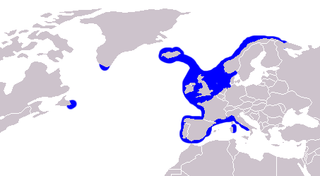
The common ling, also known as the white ling or simply the ling, is a large member of the family Lotidae, a group of cod-like fishes. It resembles the related rocklings, but it is much larger and has a single barbel. This species is unrelated to the pink ling, Genypterus blacodes, from the Southern Hemisphere. The common ling is found in the northern Atlantic, mainly off Europe, and into the Mediterranean Basin. It is an important quarry species for fisheries, especially in the northeastern Atlantic, although some doubts exist as to the sustainability of the fisheries. As an edible species, it is eaten fresh, frozen, or dried, but also preserved in lye, while the roe is a delicacy in Spain.
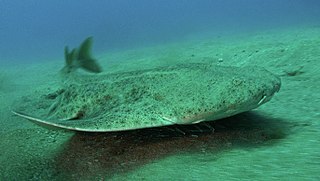
Squatina squatina, the angelshark or monkfish, is a species of shark in the family Squatinidae, that were once widespread in the coastal waters of the northeastern Atlantic Ocean. Well-adapted for camouflaging itself on the sea floor, the angelshark has a flattened form with enlarged pectoral and pelvic fins, giving it a superficial resemblance to a ray. This species can be identified by its broad and stout body, conical barbels, thornless back, and grayish or brownish dorsal coloration with a pattern of numerous small light and dark markings. It measures up to 2.4 m (7.9 ft) long.
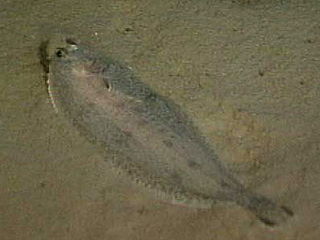
The witch, known in English by a variety of other common names including the witch flounder, pole flounder, craig fluke, Torbay sole, and grey sole, is a species of flatfish from the family Pleuronectidae. It occurs on both sides of the North Atlantic Ocean on muddy sea beds in quite deep water. In northern Europe it has some importance in fisheries as a food fish.

The solenette or yellow sole, Buglossidium luteum, is a species of flatfish in the family Soleidae, and the only member of its genus. It is characterized by its small size, low-slung semi-circular mouth, and regularly placed dark fin rays. A common and widespread species, it is native to sandy bottoms in the northeastern Atlantic Ocean and the Mediterranean Sea. It is of little commercial value.
The spotted dragonet is a species of dragonet native to the eastern Atlantic Ocean and the Mediterranean Sea where it occurs at depths of from 45 to 650 metres. This species is important to local peoples engaged in subsistence fishing.

The red gurnard, also known as the East Atlantic red gurnard or soldier, is a benthic species of ray-finned fish belonging to the family Triglidae, the gurnards and sea robins. This fish is found in the eastern Atlantic Ocean, including the Mediterranean Sea and the Black Sea.
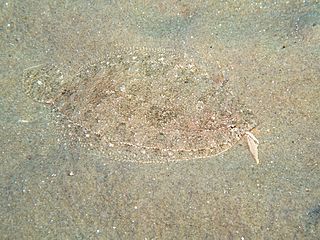
Thor's scaldfish is a species of bottom feeder benthic fish belonging to the family Bothidae. It is widespread in the Eastern Atlantic from Ireland to Sierra Leone and Cape Verde, and also found in the western Mediterranean and Black Sea. It is a marine, subtropical, demersal fish, up to 18 cm in length.

The Egyptian sole is a species of flatfish in the true sole family, Soleidae. It lives on the sandy or muddy seabed of the Mediterranean Sea, and is now colonising the Red Sea. It often semi-immerses itself in the substrate. The upper side is greyish-brown while the underside is white. It grows to a maximum length of about 70 cm (28 in). This fish is used for human consumption and is prized as a food fish. It is caught mostly by trawling on the seabed.

Upeneus moluccensis, the goldband goatfish, golden-banded goatfish or Moluccan goatfish, is a species of Indo-Pacific goatfish from the red mullet and goatfish family, the Mullidae. It is widespread in the warmer waters of the Indian and Pacific Oceans as far east as New Caledonia and has colonised the eastern Mediterranean Sea from the Red Sea via the Suez Canal, making it a Lessepsian migrant.
Arnoglossus imperialis, the imperial scaldfish, is a species of flatfish from the family of left-eyed flounders, the Bothidae. It occurs in the eastern Atlantic from Scotland south to Namibia, extending into the western Mediterranean. This bottom dwelling species is sometimes caught as bycatch but is of little interest to fisheries.

Solea senegalensis, the Senegalese sole, is a species of flatfish from the family of the true soles, the Soleidae, from the eastern Atlantic and the Mediterranean Sea.
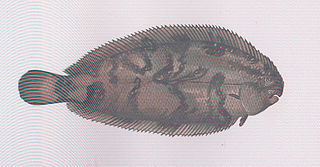
The thickback sole, also known as the bastard sole and lucky sole, is a species of flatfish from the family of true soles, the Soleidae. It is found in the eastern Atlantic Ocean and the Mediterranean Sea, it is a quarry for fisheries in the Mediterranean.

Trachyrincus scabrus, the roughsnout grenadier or Mediterranean longsnout grenadier, is a species of bathydemersal marine fish from the subfamily Trachyrincinae, part of the family Macrouridae. It is found in the eastern Atlantic Ocean and the Mediterranean.
Dagetichthys lusitanicus, commonly known as the Portuguese sole, is a species of flatfish native to the eastern Atlantic Ocean. Little is known of the abundance or behaviour of this fish, and the International Union for Conservation of Nature has rated its conservation status as being "data deficient".
Microchirus azevia, commonly known as the bastard sole, is a species of flatfish in the family Soleidae. It is found on the continental slope of the eastern Atlantic Ocean and the Mediterranean Sea at depths down to about 250 m (800 ft).
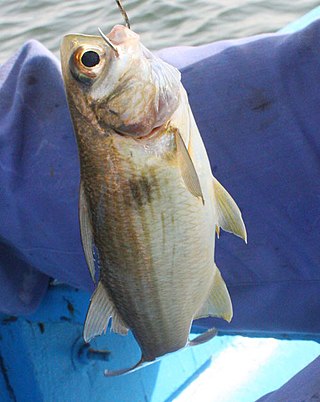
The lesser African threadfin is a species of marine ray-finned fish, a threadfin from the family Polynemidae which is found in the eastern Atlantic Ocean off the western coast of Africa.

The African striped grunt is a species of marine ray-finned fish, a sweetlips belonging to the subfamily Plectorhinchinae, one of two subfamilies in the family Haemulidae, the grunts. It is found in the eastern Atlantic Ocean.

The rubberlip grunt is a species of marine ray-finned fish, a sweetlips belonging to the subfamily Plectorhinchinae, one of two subfamilies in the family Haemulidae, the grunts. It is native to the eastern Atlantic Ocean.

The winter skate is a globally endangered species of skate found in the surrounding waters of northeastern North America. They inhabit shallow shelf waters and are prone to bycatch during commercial fishing. There are three populations or Designable Units (DU) including the Gulf of St. Lawrence population (GSL), the Eastern Scotian Shelf and Newfoundland population (ESSN), and the Western Scotian Shelf population.


















